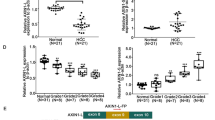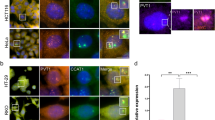Abstract
Achaete-scute like (ASCL)2 is a basic helix–loop–helix transcription factor essential for the maintenance of proliferating trophoblasts during placental development. Using oligonucleotide microarrays we identified ascl2 as a gene significantly upregulated in colorectal adenocarcinomas (n=36 cancers, n=16 normals; 15-fold, P<0.0001). This finding was confirmed by quantitative reverse transcriptase (RT)–PCR on large intestinal cancers (n=29 cancers, n=16 normals; 10-fold, P<0.0001). In situ hybridization for ascl2 demonstrated expression at the base of small and large intestinal crypts (n=304), but in no other normal tissues excepting placenta. By in situ hybridization, 52–71% of colorectal adenomas (n=187), 50–73% of large (n=327) and 33–64% of small intestinal adenocarcinomas (n=124) were positive for ascl2 expression. Upregulation of murine ascl2 was also observed using oligonucleotide microarrays, quantitative RT–PCR and in situ hybridization on apcmin/+ and apc1638N/+ smad4−/+ tumours. Tumour cell lines stably transfected with LEF1DN or APC2, or transiently transfected with short-interfering RNA (siRNA) against β-catenin showed a significant downregulation of ascl2. Colocalization of ascl2 with nuclear β-catenin was observed in 73 small intestinal adenocarcinomas (P=0.0008) and apcmin/+ tumours. Preliminary in vitro data suggest ascl2 may promote progression through the G2/M cell cycle checkpoint. In summary, ascl2 is a putative regulator of proliferation that is overexpressed in intestinal neoplasia.









Similar content being viewed by others
References
Alders M, Hodges M, Hadjantonakis AK, Postmus J, van Wijk I, Bliek J et al. (1997). Hum Mol Genet 6: 859–867.
Banerjea A, Ahmed S, Hands RE, Huang F, Han X, Shaw PM et al. (2004). Mol Cancer 3: 21.
Cui H, Horon IL, Ohlsson R, Hamilton SR, Feinberg AP . (1998). Nat Med 4: 1276–1280.
Fernandez PC, Frank SR, Wang L, Schroeder M, Liu S, Greene J et al. (2003). Genes Dev 17: 1115–1129.
Guillemot F, Caspary T, Tilghman SM, Copeland NG, Gilbert DJ, Jenkins NA et al. (1995). Nat Genet 9: 235–242.
Guillemot F, Lo LC, Johnson JE, Auerbach A, Anderson DJ, Joyner AL . (1993). Cell 75: 463–476.
Guillemot F, Nagy A, Auerbach A, Rossant J, Joyner AL . (1994). Nature 371: 333–336.
Herman JG, Graff JR, Myohanen S, Nelkin BD, Baylin SB . (1996). Proc Natl Acad Sci USA 93: 9821–9826.
Hernandez S, Bessa X, Bea S, Hernandez L, Nadal A, Mallofre C et al. (2001). Lab Invest 81: 465–473.
Johnson JE, Birren SJ, Anderson DJ . (1990). Nature 346: 858–861.
Jubb AM, Landon TH, Burwick J, Pham TQ, Frantz GD, Cairns B et al. (2003). J Pathol 200: 577–588.
Leow CC, Romero MS, Ross S, Polakis P, Gao WQ . (2004). Cancer Res 64: 6050–6057.
Massari ME, Murre C . (2000). Mol Cell Biol 20: 429–440.
Miyamoto T, Hasuike S, Jinno Y, Soejima H, Yun K, Miura K et al. (2002). J Assist Reprod Genet 19: 240–244.
Morison IM, Ramsay JP, Spencer HG . (2005). Trends Genet 21: 457–465.
Myohanen SK, Baylin SB, Herman JG . (1998). Cancer Res 58: 591–593.
Olmeda D, Castel S, Vilaro S, Cano A . (2003). Mol Biol Cell 14: 2844–2860.
Rodel F, Hoffmann J, Distel L, Herrmann M, Noisternig T, Papadopoulos T et al. (2005). Cancer Res 65: 4881–4887.
Sansom OJ, Reed KR, Hayes AJ, Ireland H, Brinkmann H, Newton IP et al. (2004). Genes Dev 18: 1385–1390.
van de Wetering M, Sancho E, Verweij C, de Lau W, Oving I, Hurlstone A et al. (2002). Cell 111: 241–250.
Westerman BA, Neijenhuis S, Poutsma A, Steenbergen RD, Breuer RH, Egging M et al. (2002). Clin Cancer Res 8: 1082–1086.
Westerman BA, Poutsma A, Looijenga LH, Wouters D, van Wijk IJ, Oudejans CB . (2001). Placenta 22: 511–518.
Yang S, Toy K, Ingle G, Zlot C, Williams PM, Fuh G et al. (2002). Arterioscler Thromb Vasc Biol 22: 1797–1803.
Zhang T, Otevrel T, Gao Z, Ehrlich SM, Fields JZ, Boman BM . (2001). Cancer Res 61: 8664–8667.
Zheng S, Chen P, McMillan A, Lafuente A, Lafuente MJ, Ballesta A . (2000). Carcinogenesis 21: 2057–2064.
Author information
Authors and Affiliations
Corresponding author
Additional information
Supplementary Information accompanies the paper on Oncogene website (http://www.nature.com/onc).
Rights and permissions
About this article
Cite this article
Jubb, A., Chalasani, S., Frantz, G. et al. Achaete-scute like 2 (ascl2) is a target of Wnt signalling and is upregulated in intestinal neoplasia. Oncogene 25, 3445–3457 (2006). https://doi.org/10.1038/sj.onc.1209382
Received:
Revised:
Accepted:
Published:
Issue Date:
DOI: https://doi.org/10.1038/sj.onc.1209382
- Springer Nature Limited
Keywords
This article is cited by
-
ASCL2 induces an immune excluded microenvironment by activating cancer-associated fibroblasts in microsatellite stable colorectal cancer
Oncogene (2023)
-
Genome-wide profiling in colorectal cancer identifies PHF19 and TBC1D16 as oncogenic super enhancers
Nature Communications (2021)
-
Genetic and epigenetic basis of hepatoblastoma diversity
Nature Communications (2021)
-
Hyperactivated Wnt-β-catenin signaling in the absence of sFRP1 and sFRP5 disrupts trophoblast differentiation through repression of Ascl2
BMC Biology (2020)
-
Stem Cell Marker Expression in Early Stage Colorectal Cancer is Associated with Recurrent Intestinal Neoplasia
World Journal of Surgery (2020)




